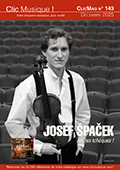 Le disque Beethoven, Mozart : Quatuors à cordes par le Primrose Quartet est une pépite ressuscitée, capturant l’alchimie d’un ensemble légendaire éclipsé par l’Histoire. Cet enregistrement, tiré de diffusions en direct de 1939, nous plonge dans l’âge d’or des quatuors à cordes, porté par un ensemble d’une virtuosité rare. Chacun de ces musiciens, formé par les plus grands maîtres, apporte une maîtrise technique et une expressivité qui transcendent les partitions. Leur interprétation de Beethoven et Mozart, mariant virtuosité flamboyante et cohésion organique, révèle une audace rare. Elle est d’une clarté et d’une intensité remarquables. Les phrasés sont ciselés, les dynamiques parfaitement maîtrisées, et l’équilibre entre les voix est un modèle du genre. On sent une complicité palpable entre les musiciens, qui jouent avec une énergie scénique qui transpire dans chaque mouvement et une précision quasi surhumaines. La qualité de l’enregistrement live de 1939, restauré avec soin, offre un son d’époque aux contours chaleureux, malgré quelques aspérités témoignant de leur authenticité. Entre prouesse technique et émotion brute, ce disque nous offre un aperçu unique de ce qu’aurait pu être leur héritage. Une redécouverte essentielle et un rendez-vous incontournable avec des géants oubliés. (Mathieu Niezgoda)  The Primrose String Quartet was undoubtedly one of the most virtuosic ensembles ever assembled. Established by the Radio Corporation of America (RCA), it featured the most prominent members from Arturo Toscanini’s legendary NBC Symphony Orchestra, and was named after the remarkable violist William Primrose. Born in Glasgow in 1904, Primrose began his career as a violinist studying with the great Eugène Ysaÿe before switching to the viola in his early 20s. He soon estabished a major solo career and was regarded as the leading viola soloist of his era. While playing in the NBC Symphony, Primrose made numerous solo recordings for the RCA label, and in 1938 a resident string quartet with members of the NBC Symphony was established.With the outstanding Josef Gingold, one of Eugène Ysaÿe’s prize students, on second violin, the 21-year-old Oscar Shumsky – whom Primrose declared to be ‘one of the greatest virtuosos I have ever heard’ – was appointed as the Quartet’s first violinist. With the American-born cellist Harvey Shapiro, who studied with Julius Klengel in Germany, the Primrose Quartet was finally established. According to Primrose, ‘I am quite convinced – and am conceited enough to say so – that no quartet ever played that had the instrumental ability of my quartet....The group had no cripple; we all played in a virtuoso matter.’In 1940, the Primrose Quartet made several recordings for RCA Victor, and was well on its way to become the premier quartet ensemble in the United States. Unfortunately, the US entry into Second World War at the end of 1941 and the American Federation of Musicians strike a year later seriously curtailed recording activity for all musical artists. Although the Primrose Quartet never recorded a Beethoven quartet for RCA, this CD release of live broadcast recordings from 1939 offers a glimpse into what their recorded Beethoven legacy might have been
 |
